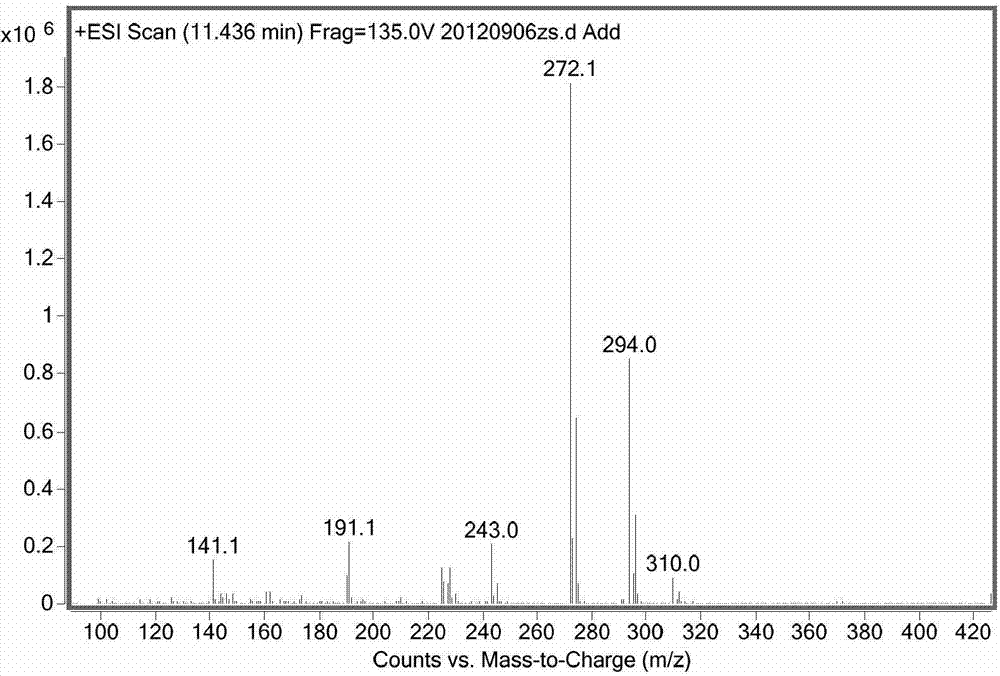Pseudoxanthomonas indica and application thereof in degrading chloronicotinyl insecticide imidacloprid
A nicotinic insecticide, the technology of Pseudomonas, applied in the field of microorganisms, can solve the problems of increasing the risk of IMI
- Summary
- Abstract
- Description
- Claims
- Application Information
AI Technical Summary
Problems solved by technology
Method used
Image
Examples
example 1
[0021] Example 1: Isolation, screening, identification and biological characteristics of biodegradable IMI strains
[0022] 1. Strain isolation
[0023] Collect soil from Xianlin area, Nanjing City, Jiangsu Province, add 2g of soil to 18mL sterile water containing 5 glass beads, shake for 10min, let it stand for 5min, take 1ml of the suspension and add it to 19ml of mineral salt medium containing 200mg / LIMI . The composition of the mineral salt medium is: 1.36g / LKH 2 PO 4 , 2.13 gL Na 2 HPO 4 , 0.5gL MgSO 4 ·7H 2 O and 10ml / L metal ion liquid, pH7.5. The composition of the metal ionic liquid is: 0.40gL CaCl 2 2H 2 O,0.30g / L H 3 BO 3 ,0.04gL CuSO 4 ·5H 2 O, 0.10g / L KI, 0.20g / L FeSO 4 ·7H 2 O, 0.40g / LMnSO 4 ·7H 2 O, 0.20g / LNaMoO 4 2H 2 O and 10.0mL / L concentrated hydrochloric acid. The samples were incubated for one month at 30°C in a shaker with a rotational speed of 220rpm. Take 100 μl sample and dilute to 10 -3 and 10 -4 Afterwards, LB plates were coate...
Embodiment 2
[0030] The Pseudoxanthomonas indica CGMCC6648 stored at -80°C was streaked on LB solid medium and cultured in a 30°C incubator. A single colony was picked and inoculated into a 100 mL Erlenmeyer flask containing 25 mL of LB liquid medium, and cultured at 30°C with shaking at 220 rpm for 24 hours. Inoculate 1% of the inoculum into a 500mL Erlenmeyer flask containing 100mL LB liquid medium, culture at 30°C for 12h with shaking at 220rpm, when OD 600 When the value reaches 5, take 10ml of the bacterial liquid and centrifuge at 8000rpm for 5min at 4°C to collect the bacterial cells. Phosphate buffered saline (0.2mol / LNa 2 HPO 4 / KH 2 PO 4 , pH7.5) After washing twice, suspend in 10mL IMI phosphate buffer containing 500mgL. Take 2ml of the above-mentioned transformation reaction solution, divide it into three 50ml centrifuge tubes, each tube contains 2ml, and shake and culture at 30°C and 220rpm for 48h. HPLC analysis ( image 3 ) IMI degradation and 5-hydroxy IMI generation...
Embodiment 3
[0032] Basically the same as example two, just added the glucose of 100mmol / L in the phosphate buffer solution, HPLC analysis ( Figure 4 ) results showed that IMI decreased by 0.66mmol / L, and 0.59mmol / L 5-hydroxy IMI was generated at the same time, and the degradation rate of IMI was 43.6%. The above results indicated that glucose can greatly promote the degradation of IMI and the generation of 5-hydroxy IMI.
[0033] Under the same culture and transformation conditions, Stenotrophomonas maltophilia CGMCC1.1788 was used to replace Pseudomonas CGMCC6648, HPLC analysis ( Figure 5 ) results showed that IMI decreased by 0.48mmol / L, and 0.40mmol / L 5-hydroxy IMI was generated at the same time, and the degradation rate of IMI was 28.2%. The above results indicated that Pseudoxanthomonas indica CGMCC6648 had much higher IMI degradation and hydroxylation abilities than Stenotrophomonas maltophilia CGMCC1.1788.
PUM
 Login to View More
Login to View More Abstract
Description
Claims
Application Information
 Login to View More
Login to View More - R&D
- Intellectual Property
- Life Sciences
- Materials
- Tech Scout
- Unparalleled Data Quality
- Higher Quality Content
- 60% Fewer Hallucinations
Browse by: Latest US Patents, China's latest patents, Technical Efficacy Thesaurus, Application Domain, Technology Topic, Popular Technical Reports.
© 2025 PatSnap. All rights reserved.Legal|Privacy policy|Modern Slavery Act Transparency Statement|Sitemap|About US| Contact US: help@patsnap.com



